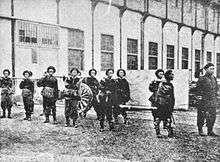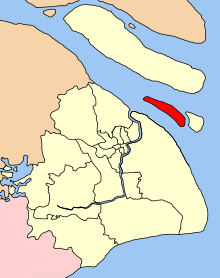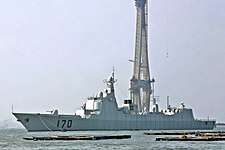Jiangnan Shipyard
Jiangnan Shipyard (Chinese: 江南造船厂; pinyin: Jiāngnán Zàochuán Chǎng) is a historic shipyard in Shanghai, China. The shipyard has been state-owned since its founding in 1865 and is now operated as Jiangnan Shipyard (Group) Co. Ltd.
Native name | 江南造船(集团)有限责任公司 |
|---|---|
| Subsidiary | |
| Industry | Shipbuilding |
| Founded | 1865 |
| Headquarters | Shanghai, China |
Area served | Worldwide |
| Parent | China State Shipbuilding Corporation (CSSC) |
| Website | jnshipyard.cssc.net.cn |
Before 2009, the company was south of central Shanghai at 2 Gaoxing Road (31°11′49″N 121°28′59″E). In 2009, the shipyard was moved to Changxing Island, in the mouth of the Yangtze River to the north of urban Shanghai. (31°21′14.81″N 121°44′14.69″E).
The shipyard builds, repairs and converts both civilian and military ships. Other activities include the manufacture of machinery and electrical equipment, pressure vessels and steel works for various land-based products.
History
Kiangnan Arsenal

The origins of the Jiangnan Shipyard lie in the Self-Strengthening Movement of the late 19th century in China, during the Qing Dynasty. The Self-Strengthening Movement (Chinese: 洋務運動/自強運動/同治維新), c. 1861 – 1895, was a period of institutional reforms initiated in China during the late Qing dynasty following a series of military defeats and concessions to foreign powers. One of the projects in this campaign of modernisation was the establishment of defence industries, including the Kiangnan Arsenal in Shanghai in 1865 (the fourth year of the Tongzhi era). Plans for the arsenal were established under Zeng Guofan, who served as Viceroy of Liangjiang, although its actual establishment became the responsibilities of Li Hongzhang.
The Manderin Chinese name of the Kiangnan Arsenal was the General Bureau of Machine Manufacture of Jiangnan (Chinese: 江南機器製造總局; pinyin: Jiāngnán Jīqì Zhìzào Zǒngjú), or the Jiangnan (or Kiangnan) Machine Works for short. It was established to both manufacture firearms and also build naval vessels. The shipyard, plant and machinery were initially leased from Thomas Hunt and Company, an American firm within the concessions of Shanghai. Due to the influx of workers and the reluctance of the concession authorities to allow arms to be manufactured within their territory, the Chinese authorities purchased the plant and equipment and combined these with the existing assets of the old Suzhou and Anqing arsenals as well as new equipment purchased by Yung Wing in the United States to form the new Kiangnan Arsenal in 1865.
The Kiangnan Arsenal was the largest of the arsenals established during the Self-Strengthening Movement, and also the one with the largest budget—from 1869, its annual budget was more than 400,000 silver taels. A series of high officials, including Zeng Guofan, Zuo Zongtang, and Zhang Zhidong, served as its head, although Li Hongzhang served the longest term during the Qing Dynasty. Most of the senior technical staff were Westerners, such as the first chief engineer, American T. F. Falls, and prolific translator John Fryer.[1]
During the Tongzhi era, the Arsenal was the largest weapons factory in East Asia. Among its other achievements were the first domestically produced steam boat (the Huiji) in 1868 and the first domestically produced steel in 1891.
As well as its manufacturing works, the Arsenal also comprised a language school, a translation house and a technical school.
Kiangnan Shipyard
In 1905, the shipbuilding operations of the Kiangnan Arsenal were de-merged into the separate Kiangnan Shipyard. In the 1920s Kiangnan built six new river gunboats for the US Navy South China Patrol on the Yangtze River.
The remaining arms manufacturing arm of the Kiangnan Arsenal operated until its dissolution in 1937, at the outbreak of the Second Sino-Japanese War. The shipyard was evacuated to Chongqing and re-established as the Chongqing Shipyard.
Large parts of the assets of both the Arsenal and the Shipyard were left behind in Shanghai to be occupied by Japanese forces during the war. During this period, the Japanese occupying forces absorbed the plant and equipment of the Arsenal into the Shipyard. This combination was not reversed after the surrender of Japan.
Jiangnan Shipyard after 1949

After the establishment of the People's Republic of China under the Communist Party of China in 1949, the shipyard changed its Chinese name to the Jiangnan Shipbuilding Factory (Chinese: 江南造船廠; pinyin: Jiāngnán Zàochuán Chǎng) in 1953. The shipyard was corporatised in 1996 and organised as a subsidiary of the state-owned China State Shipbuilding Corporation.
Beginning in 1964, the Communist government moved a number of industrial and technological institutions of strategic importance inland, in preparation for a potential war with either the United States or the Soviet Union. The Jiangnan Shipyard was again moved to Chongqing during this period. Although the shipyard subsequently moved back to Shanghai, it retains two subsidiary shipyards in Chongqing.
The Jiangnan Shipyard remained a focus of investment by the Chinese government during this period. Amongst other "firsts" in the People's Republic were the first ten-thousand-tonne hydraulic forging press, the first domestically designed ocean-going freight ship, the first ocean exploration and communication ship, the first liquid petroleum tanker, and the first sea-crossing train ferry.
In August 2000, the Qiuxin Shipyard became a wholly owned subsidiary, although its name and identity remain.
In 2010, the shipyard was requisitioned for Expo 2010. The shipyard's operations moved to Changxing Island, an island within Shanghai Municipality at the mouth of the Yangtze River.
Staffing
The total staffing is about 10,500. Of this:
- senior engineers: 450
- engineers and technicians: 750
- technical professionals: 2,700
- skilled workers: 4,500
Ship building

The shipyard main production is: liquefied gas carriers, car carriers, crude oil tankers, Panamax bulk carriers, Handymax bulk carriers, Lake suitable bulk carriers, multi-purpose cargo ships, and fast feeder container ships.
Recent specialised ships include:
The works are ISO 9001 accredited.
The works' two building berths can build to :
- 275m x 40m - 80,000 DWT (deadweight tons)
- 242m x 24m - 35,000 DWT
Three dry docks have capacities between 3,000 and 80,000 DWT.
The works has 16 designated assembly areas with various capabilities.
See also
References
- Bennett, Adrian Arthur (1967). "John Fryer: The Introduction of Western Science and Technology into Nineteenth-Century China". Harvard East Asian Monographs. 24.
External links
- Official website (in Chinese)
- Official website (in English)
- listing by GlobalSecurity.org
- Collection of photos of ships built by Jiangnan Shipyard